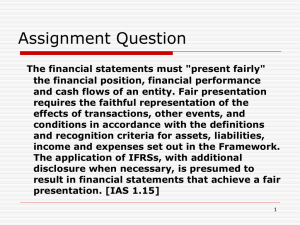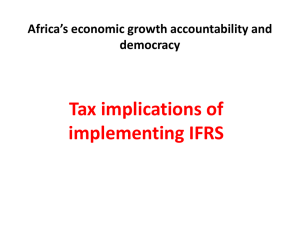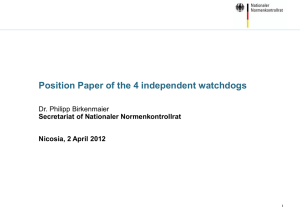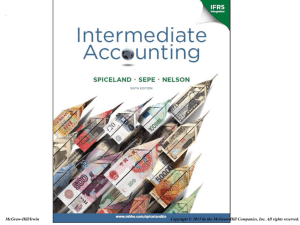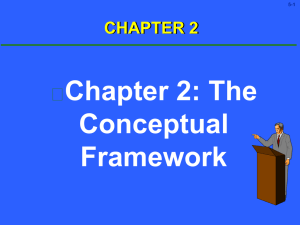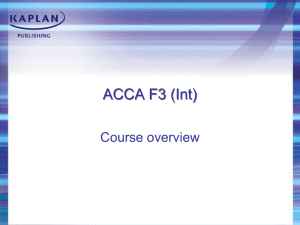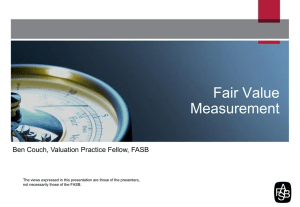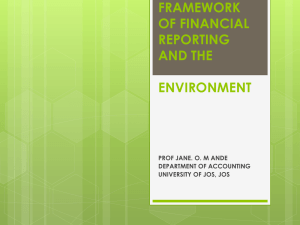国际财务报告准则最新发展动态
advertisement
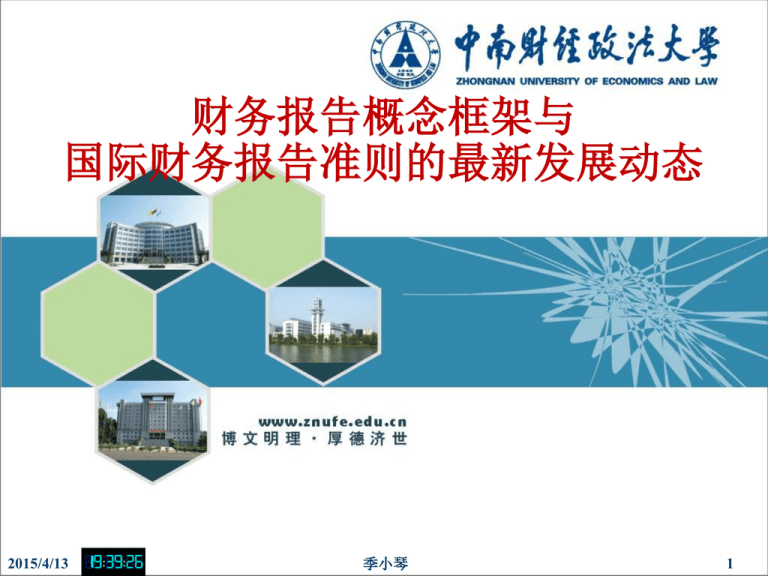
财务报告概念框架与 国际财务报告准则的最新发展动态 2015/4/13 季小琴 1 2015/4/13 2 这是一本关于华尔街历史的书,也是一本关于 美国金融史和经济史的书。它所描述的历史事 件使我们清晰地看到,在很大程度上,华尔街 推动了美国从一个原始而单一的经济体成长为 一个强大而复杂的经济体。在美国经济发展的 每一个阶段中,以华尔街为代表的美国资本市 场都扮演着重要的角色。华尔街为美国经济的 发展提供源源不断的资金,实现社会资源的优 化配置,而华尔街本身也伴随着美国经济的发 展而成长为全球金融体系的中心。美国经济的 成功是资本市场和实体经济之间协同发展很好 的例证。 节选《序》——易纲 2015/4/13 3 经济周期是人类本性所导致的必然结果。当经济 好的时候,人们对未来过于乐观,盲目扩张,该 裁减的冗员没有裁减。于是,坏年景很快就来了 ,人们又变得过于悲观,这样周而复始,循环往 复。当市场崩溃时,每个人都想要现金或黄金, 可是,此时市场上恰恰最缺乏流动性。因为没有 作为最后贷款人的中央银行,人们就会失去信心 ,所以,历史上的美国经常面临恐慌,也经常经 历比其他国家更为迅猛的繁荣和更为深重的崩溃 ,美国经济周期的振幅也远远大于欧洲。 节选《华尔街的昨天和今天——译者和作者的对话》 2015/4/13 4 但是,有趣的是,这些股市崩溃,也有对美国经 济有利的一面。在历史上相当长的时间里,英国 比美国富有得多,美国人修建铁路,开办工厂, 需要资金,英国人则到美国股市来投资。美国人 修成了铁路和工厂,英国人成为了这些铁路和工 厂的所有者。但是,当股市崩溃时,英国人就会 把这些股票低价抛售给美国人。结果,美国人既 得到了铁路和工厂,又拿回了这些铁路和工厂的 所有权,变相地洗劫了英国的财富。 节选《华尔街的昨天和今天——译者和作者的对话》 2015/4/13 报告人:王昌锐 5 从长期来看,一个完全自由的市场是一定会崩溃 的。胡佛曾说过,资本主义的最大问题是资本家 本身——他们太贪婪,他们总是牺牲市场整体利 益来服务于他们自己的利益。任何一个市场都需 要警察和裁判,你可以想象,一个没有警察的社 会人们甚至可能在停车场里相互杀戮,一场没有 裁判的橄榄球赛将会是一场灾难。一个自由的市 场并不是一个没有监管的市场,市场需要有人仲 裁,也需要有人来制订规则。但我们必须要保证 裁判的公正性,要特别小心是谁在制订规则,规 则是服务于谁的利益。 节选《华尔街的昨天和今天——译者和作者的对话》 2015/4/13 6 Topic lists IASB/FASB财务报告概念框架最新进展 – – – – – 财务报告概念框架与公认会计准则 各国财务报告概念框架发展情况 IASB/FASB联合概念框架 FASB SFAS No 8 IASB: 2010财务报告概念框架 国际财务报告准则的最新发展 – – – 总体情况 财务报表列报准则最新变化 收入准则的最新变化 第一部分:财务报告概念框架最新发展 The Nature of Accounting 艺术论(arts) 服务活动论(service activity) 信息系统论(information system) 管理活动论(management activity) 管理工具论(management tools) 受托责任观(stewardship, or accountability) 会计契约观(accounting contracts) 信息系统论(information system) 确认(recognition) 计量(measurement) 记录(recording) 报告(reporting) 辅修论文选题与会计基本理论问题 人力资源会计问题(Human Resources Accounting ,HR) 环境会计问题(Environmental Accounting) 企业社会责任披露(Corporate Social Responsibility disclosure,CSR) 会计信息披露问题(accounting information disclosure) 会计信息失真 企业内部控制(Internal Control)与公司治理问题( Corporate Governance) 辅修论文选题与会计基本理论问题 后金融危机时代公允价值计量问题(Fair Value Measurement Post-financial crisis) 会计职业道德问题(Accounting Ethics) 政府会计(governmental accounting) 1 Conceptual Framework and GAAP 财务报告概念框架(Conceptual Framework ) Generally Accepted Accounting Principles or Generally Accepted Accounting Practice(GAAP) 公认会计准则(实务) Conceptual Framework ‘A constitution, a coherent system of interrelated objectives and fundamentals that can lead to consistent standards and that prescribes the nature, function and limits of financial accounting and financial statements. Conceptual Framework The fundamentals are the underlying concepts of accounting, concepts that guide the selection of events to be accounted for, the measurement of those events, and the means of summarizing and communicating them to interested parties. (Scope and Implications of the Conceptual Framework Project, FASB, 1976, p.2.) 概念框架 概念框架是“宪法”,是由相互依存的目标和基本概 念组成的体系,能够产生一以贯之的准则并制约着财 务会计和财务报表的性质、职能和界限。框架的最主 要内容是有关会计的基本概念,这些概念指导着对要 进行核算的事项(交易)的选择、这些事项的计量以 及汇总这些事项并向感兴趣的人士传输信息的方式。 Conceptual Framework A Conceptual Framework, is a statement of generally accepted theoretical principles which form the frame of reference for financial reporting. (ACCA, Financial reporting, F7) These theoretical principles provide the basis for the development of new accounting standards and the evaluation of those already in existence Conceptual Framework A Conceptual Framework will form the theoretical basis for determining which events should be accounted for, how they should be measured and how they should be communicated to the user. Although it is theoretical in nature, a conceptual framework for financial reporting has highly practical final aims. Generally Accepted Accounting Principles (GAAP) GAAP are the guidelines, procedures, and practices that a company is required to use in recording and reporting the accounting information in its audited financial statements. They are like laws and are the rules that must be followed in financial reporting. Hierarchy of Sources of GAAP A. Pronouncements of authoritative bodies (FASB, APB, CAP, SEC). B. Pronouncements of bodies of expert accountants that have been exposed for public comment. C. Pronouncements of bodies of expert accountants that have not been exposed for public comment. Continued Hierarchy of Sources of GAAP D. Widely accepted practices and pronouncements representing prevalent practice in a particular industry or applications to specific circumstances. E. Other accounting literature. GAAP GAAP signifies all the rules, from whatever source, which govern accounting In individual countries this is seen primarily as a combination of: – – – National company law National accounting standards Local stock exchange requirements Also include non-mandatory sources such as – – International accounting standards Statutory requirements in other countries 概念框架作用 Assist auditors in forming an opinion whether financial statements conform with IAS/IFS/ US GAAP/ UK FRS Assist users of financial statements in interpreting the information contained in financial statements prepared in conformity with IAS Provide those who are interested in the work of FASB/IASC/ASB with information about its approach to the formulation of IAS(ACCA textbook) 性质和地位 Generally-Agreed (accepted) theory underpinning financial accounting , designed to underpin the development of accounting standards It is not an accounting standard itself. Nothing in the Framework overrides a specific national or international accounting standard FASB 的概念框架 SFAC No.1 Objective of Financial Reporting by Business Enterprises(Nov. 1978) SFAC No.2 Qualitative Characteristics of Accounting Information(May 1980) SFAC No.3 Elements of Financial Statements( 1980, suspended by No.6) SFAC No.4, Objective of Financial Reporting by NonBusiness Organizations(Nov. 1978) SFAC No. 5 Recognition and Measurement in Financial Statements of Business Enterprises( Dec. 1984) SFAC No.6 Elements of Financial Statements(Dec1985) SFAC No.7 Using Cash Flow Information and Present Value in Accounting Measurements(Feb 2000) The IASB’s Framework(1989) The objective of financial statements Underlying assumptions( Accounting postulate) Qualitative characteristics of financial statements The elements of financial statements – – – Recognition of the elements of financial statements Measurement of the elements of financial statements Concepts of capital and capital maintenance ASB’S SoP chapter1. the objective of Financial statements chapter2. The reporting entity chapter3. The qualitative characteristics of financial statements chapter4. The elements of Financial Statements chapter5. Recognition in Financial Statements chapter6. Measurement in Financial Statements chapter7. Presentation of financial information Chapter8 Accounting for interests in other entities Conceptual Framework Overview Objectives of Financial Reporting Qualitative Characteristics of Information Accounting Elements of Financial Statements Recognition and Measurement Concepts Assumptions Principles Constraints 财务报告概念框架内容 财务报告目标 基本假设 财务报告信息质量特征 财务报表要素 财务报表要素的确认 财务报表要素的计量 财务报告 2 IASB/FASB Joint Conceptual Framework Project Objective: to develop a common and improved conceptual framework that will replace both Boards’ existing conceptual frameworks. IASB/FASB Joint Conceptual Framework Project A B Objectives and qualitative characteristics Definitions, recognition and de-recognition of elements of financial statements C Initial and subsequent measurement of elements of financial statements D Reporting entity concept E Boundaries of financial reporting, and presentation and disclosure F Purpose and status of the framework G Application of the framework to not-for-profit entities H Remaining issues, IASB/FASB Joint Conceptual Framework Project DISCUSSION PAPER(2006) Preliminary Views on an improved Conceptual Framework for Financial Reporting: The Objective of Financial Reporting and Qualitative Characteristics of Decisionuseful Financial Reporting Information EXPOSURE DRAFT(2008) FASB SFAS No 8 Statement of Financial Accounting Concepts No. 8 (September 2010 ) Conceptual Framework for Financial Reporting Chapter 1, The Objective of General Purpose Financial Reporting, and Chapter 3, Qualitative Characteristics of Useful Financial Information IASB Conceptual Framework for Financial Reporting 2010 INTRODUCTION Purpose and status Scope CHAPTERS 1 The objective of general purpose financial reporting OB1–OB21 2 The reporting entity to be added 3 Qualitative characteristics of useful financial information QC1–QC39 4 The Framework (1989): the remaining text Underlying assumption 4.1 The elements of financial statements 4.2–4.36 Recognition of the elements of financial statements 4.37–4.53 Measurement of the elements of financial statements 4.54–4.56 Concepts of capital and capital maintenance 4.57–4.65 IASB Conceptual Framework for Financial Reporting 2010—Objectives The objective of general purpose financial reporting is to provide financial information about the reporting entity that is useful to existing and potential investors, lenders and other creditors in making decisions about providing resources to the entity. Those decisions involve buying, selling or holding equity and debt instruments, and providing or settling loans and other forms of credit IASB Conceptual Framework for Financial Reporting 2010—Objectives Information about a reporting entity’s economic resources, claims, and changes in resources and claims – – Economic resources and claims Changes in economic resources and claims IASB Conceptual Framework for Financial Reporting 2010—Objectives OB15 Changes in a reporting entity’s economic resources and claims result from that entity’s financial performance (see paragraphs OB17–OB20) and from other events or transactions such as issuing debt or equity instruments (see paragraph OB21). To properly assess the prospects for future cash flows from the reporting entity, users need to be able to distinguish between both of these changes. IASB Conceptual Framework for Financial Reporting 2010—Objectives OB16 Information about a reporting entity’s financial performance helps users to understand the return that the entity has produced on its economic resources. Information about the return the entity has produced provides an indication of how well management has discharged its responsibilities to make efficient and effective use of the reporting entity’s resources. IASB Conceptual Framework for Financial Reporting 2010—Objectives Information about the variability and components of that return is also important, especially in assessing the uncertainty of future cash flows. Information about a reporting entity’s past financial performance and how its management discharged its responsibilities is usually helpful in predicting the entity’s future returns on its economic resources. 关于财务报告目标的最新变化 财务报告的两大目标 – – 决策有用观 受托责任观 财务报告的单一目标 通用财务报告的目标 目标在概念框架中的地位 谁是财务信息的主要使用者 他们需要信息的总目标 为满足主要使用者的需要,财务报告能够提供 哪些信息,这些信息性质特点(作用)如何 你的观点? 受托责任观与会计本质 受托责任观与财务报告概念框架的其他内容 – – – 会计信息质量特征 受托责任观与会计计量 受托责任观与资产要素的定义 受托责任观与公司治理 受托责任观与社会环境报告 受托责任观与会计诚信 IASB CF2010: Qualitative Characteristics Fundamental qualitative characteristics – – – – Enhancing qualitative characteristics – – – – – Relevance Materiality Faithful representation Applying the fundamental qualitative characteristics Comparability Verifiability Timeliness Understandability Applying the enhancing characteristics THE COST CONSTRAINT ON USEFUL FINANCIAL REPORTING Financial Reporting Financial Statements – – – – Statement of financial position Comprehensive income Statement of cash flows Statement of changes in equity Notes to the financial statement Management Discussion and Analysis Other reports Traditional Assumptions of the Accounting Model Accounting entity. Going concern. Arm’s-length transactions. Accounting period Stable monetary unit. Main References 葛家澍 陈朝琳.《财务报告概念框架的新篇 章——评美国FASB第8号概念公告》.( 2010年9月)《会计研究》,2011年第3期 FASB. Statement of Financial Accounting Concepts No. 8 (September 2010 ) IASB Conceptual Framework for Financial Reporting 2010 www.iasb.org IASB IASs or IFRSs IFRS1 First-time Adoption of International Financial Reporting Standards 《IFRS1——初次采用国际财务报告准则》 IFRS2 Share-based Payment 《IFRS2——以股份为基础的支付》 IFRS3 Business Combinations 《IFRS3——企业合并》 IFRS4 Insurance Contracts IASB IFRSs or IASs 《IFRS4——保险合同》 IFRS5 Non-current Assets Held for Sale and Discontinued Operations 《IFRS5——持有以备出售的非流动资产和终止经营 》 IFRS6 Exploration for and Evaluation of Mineral Resources 《IFRS6——矿产资源的勘探和评价》 IFRS7 Financial Instruments: Disclosure 《IFRS7——金融工具:披露》 IASB IFRSs or IASs IAS 1 Presentation of Financial Statements 《IAS1——财务报表的列报》 IAS 2 Inventories 《IAS2——存货》 《IAS3》被《IAS27》和《IAS28》取代 《IAS4》被《IAS16》、《IAS22》和《IAS38》取代 《IAS5》被《IAS1》取代 《IAS6》被《IAS15》取代 IAS 7 Cash Flow Statements 《IAS7——现金流量表》 IASB IASs or IFRSs IAS 8 Accounting Policies, Changes in Accounting Estimates and Errors 《IAS8——当期净损益、重大差错和会计政策变更》 《IAS9》被《IAS38》取代 IAS 10 Events after the Balance Sheet Date 《IAS10——资产负债表日后事项》 IAS 11 Construction Contracts 《IAS11——建造合同》 IASB IASs or IFRSs IAS 12 Income Taxes 《IAS12——所得税》 《IAS13》被《IAS1》取代 IAS 14 Segment Reporting 《IAS14——分部报告》 《IAS15——反映物价变动影响的信息》 IASB IASs or IFRSs IAS 16 Property, Plant and Equipment 《IAS16——不动产、厂场和设备》 IAS 17 Leases 《IAS17——租赁》 IAS 18 Revenue 《IAS18——收入》 IAS 19 Employee Benefits 《IAS19——雇员福利》 IAS 20 Accounting for Government Grants and Disclosure of Government Assistance 《IAS20——政府补助会计和政府援助的披露》 IAS 21 the Effects of Changes in Foreign Exchange Rates 《IAS21——汇率变动的影响》 IASB IASs or IFRSs 《IAS22——企业合并》 IAS 23 Borrowing Costs 《IAS23——借款费用》 IAS 24 Related Party Disclosures 《IAS24——关联方披露》 《IAS25——投资会计》 IAS 26 Accounting and Reporting by Retirement Benefit Plans 《IAS26——退休福利计划的会计和报告》 IASB IASs or IFRSs IAS 27 Consolidated and Separate Financial Statements 《IAS27——合并财务报表及对子公司投资会计》 IAS 28 Investments in Associates 《IAS28——对联合企业投资会计》 IAS 29 Financial Reporting in Hyperinflationary Economies 《IAS29——恶性通货膨胀经济中的财务报告》 IAS 30 Disclosures in the Financial Statements of Banks and Similar Financial Institutions 《IAS30——银行和类似金融机构财务报表中的披露》 IASB IASs or IFRSs IAS 31 Interests in Joint Ventures 《IAS31——合营中权益的财务报告》 IAS 32 Financial Instruments: Disclosure and Presentation 《IAS32——金融工具:披露和列报》 IAS 33 Earnings per Share 《IAS33——每股收益》 IAS 34 Interim Financial Reporting 《IAS34——中期财务报告》 IASB IASs or IFRSs 《IAS35——终止经营》 IAS 36 Impairment of Assets 《IAS36——资产减值》 IAS 37 Provisions, Contingent Liabilities and Contingent Assets 《IAS37——准备、或有负债和或有资产》 IAS 38 Intangible Assets 《IAS38——无形资产》 IASB IASs or IFRSs IAS 39 Financial Instruments: Recognition and Measurement 《IAS39——金融工具:确认和计量》 IAS 40 Investment Property 《IAS40——投资性房地产》 IAS 41 Agriculture 《IAS41——农业》 CASs 企业会计准则—基本准则 企业会计准则第1号――存货 企业会计准则第2号——长期股权投资 企业会计准则第3号——投资性房地产 企业会计准则第4号――固定资产 企业会计准则第5号——生物资产 企业会计准则第6号——无形资产 CASs 企业会计准则第7号——非货币性资产交换 企业会计准则第8号——资产减值 企业会计准则第9号——职工薪酬 企业会计准则第10号—企业年金基金 企业会计准则第11号——股份支付 企业会计准则第12号——债务重组 企业会计准则第13号——或有事项 企业会计准则第14号——收入 企业会计准则第15号——建造合同 企业会计准则第16号——政府补助 CASs 企业会计准则第17号——借款费用 企业会计准则第18号——所得税 企业会计准则第19号——外币折算 企业会计准则第20号——企业合并 企业会计准则第21号——租赁 企业会计准则第22号——金融工具确认和计量 企业会计准则第23号——金融资产转移 企业会计准则第24号——套期保值 CASs 企业会计准则第25号——原保险合同 企业会计准则第26号——再保险合同 企业会计准则第27号——石油天然气开采 企业会计准则第28号——会计政策、会计估计 变更和差错更正 企业会计准则第29号——资产负债表日后事项 企业会计准则第30号——财务报表列报 CASs 企业会计准则第31号——现金流量表 企业会计准则第32号——中期财务报告 企业会计准则第33号——合并财务报表 企业会计准则第34号——每股收益 企业会计准则第35号——分部报告 企业会计准则第36号——关联方披露 企业会计准则第37号——金融工具列报 企业会计准则第38号——首次执行企业会计准则 第二部分:国际财务报告准则的变革 一、IFRS制定机构的组织架构变革 2009年1月,国际会计准则委员会基金会( International Accounting Standards Committee Foundation,简称IASCF)推动 成立了监督委员会( Monitoring Board,简 称MB) 2010年,IASCF即将更名为国际财务报告准 则基金会(IFRS Foundation) 2015/4/13 64 一、IFRS制定机构的组织架构变革 刘仲藜(2005;2008) 张为国(2007) 李飞龙(2010) 王军(2005) 刘玉廷(2008) 2015/4/13 65 二、IFRS变革时间表 Abbreviations IFRS: International Financial Reporting Standard ED: Exposure Draft AD : Agenda Decision (to add the topic to the active agenda) DP : Discussion Paper CG: Completed Guidance 2015/4/13 66 二、IFRS变革时间表 时间 项目 2010 May 2010 June 2010 Q3 2010 Q4 2011 Q1 2011 Q2 2011 H2+ 金融危机相关项目 合并财务报表 IFRS 终止确认 ED 公允价值计量 金融工具:负债分类 与计量 IFRS ED IFRS 金融工具:减值 金融工具:套期会计 2015/4/13 IFRS IFRS ED IFRS 67 二、IFRS变革时间表 时间 项目 2010 May 2010 June 2010 Q3 2010 Q4 2011 Q1 2011 Q2 2011 H2+ 与FASB备忘录项目 财务报表列报 ED 具有权益特征的金融 工具 IFRS ED 所得税 ED 合营 IFRS 租赁 ED 退休后福利 ED 收入确认 ED 2015/4/13 IFRS IFRS IFRS IFRS IFRS 68 二、IFRS变革时间表 时间 项目 2010 May 2010 June 2010 Q3 2010 Q4 2011 Q1 2011 Q2 2011 H2+ 其他项目 排放权计划 ED 采掘活动 保险合同 负债(IAS37的修订) 管理层评论 费率管制活动 2015/4/13 IFRS AD ED IFRS IFRS CG IFRS 69 三、IFRS9的主要内容 属于IFRS 9范围的金融资产的分类模式 2015/4/13 70 三、IFRS9的主要内容 主要内容 对计量规定进行修订 从四分类到两分类 用公允价值计量准则和部分可选的例外来代替 现有的规定 使财务报表能报导金融资产投资的现金流量 2015/4/13 71 三、IFRS9的主要内容 金融资产分类标准 经营模式的目标: 收取合约现金流量 按摊余成本计量,只 保留一种减值模式 保留公允价值计量选择 权,但只适用于会计不 配比 合约现金流量的特征: 纯属还本付息 所有其他金融资产: 权益工具 衍生工具 混合工具 2015/4/13 采用公允价值计量, 且其变动直接计入当 期损益,不计提减值 准备 部分战略性股权投资可 以指定为以公允价值计 量,但其变动计入其他 综合收益 72 三、IFRS9的主要内容 按摊余成本计量的条件 业务模式测试(管理目的) 企业经营模式表明持有某一金融资产的管理和 考核是基于合约现金流量的收取 合同现金流量特征测试(基本贷款特征) 合约条款规定导致在特定日期产生仅仅支付本 金以及未付本金利息的现金流量 2015/4/13 73 三、IFRS9的主要内容 业务模式测试 要求主体评估其针对债务工具的业务目标 是否收取债务工具的合同现金流量而不是 在合同到期之前通过出售来实现公允价值 变动产生的利得。这是在比个别金融工具 层次更高的层次上(如资产组合或业务单 位层次)进行确定,而非根据管理层对个 别金融工具的意图来确定。 2015/4/13 74 三、IFRS9的主要内容 合同现金流量特征测试 IFRS9将利息描述为货币的时间价值以及特定 期间内未付本金的相关信用风险的对价。 2015/4/13 75 三、IFRS9的主要内容 满足摊余成本计量标准的金融工具示例 利息采用固定利率(固定利率贷款或零息 债券) 利息采用浮动利率(根据合同规定利息与 LIBOR*挂钩的英镑贷款) 固定利率和浮动利率相结合(利息为 LIBOR加上固定差幅) *London Interbank Offered Rate,简称LIBOR 2015/4/13 76 三、IFRS9的主要内容 满足摊余成本计量标准的金融工具示例(续) 具有明确到期日,并允许借款人选择对期限为三个 月的工具按三个月的LIBOR进行支付、或对期限为 一个月的工具按一个月的LIBOR进行支付的浮动利 率金融工具 设有浮动利率上限的固定期限浮动市场利率债券 本金和利息付款额与金融工具的发行货币的非杠杠 通货膨胀指数挂钩的固定期限债券 2015/4/13 77 三、IFRS9的主要内容 不满足摊余成本计量标准的金融工具示例 可转换为发行人权益工具的债券 以反浮动利率支付的贷款(8%-LIBOR) 2015/4/13 78 三、IFRS9的主要内容 如果以摊余成本计量的债务工具在到期之 前被终止确认 修订后的IAS1《财务报表的列报》要求在综合 收益表中单独列报处置产生的利得/损失 修订后的IFRS7《金融工具:披露》要求对该 利得/损失及出售原因进行分析 2015/4/13 79 三、IFRS9的主要内容 公允价值选择权 主体可以在初始确认时作出不可撤消的选择, 将金融资产指定为以公允价值计量且其变动计 入当期损益,前提是该指定将消除或显著减少 以摊余成本计量该金融资产时产生的会计不匹 配。 示例 主体可能持有一项固定利率的应收贷款,以该贷款对一项 具有与其相匹配条款的将固定利率换成浮动利率的利率互 换进行套期。假设满足以摊余成本计量条件,如果贷款以 摊余成本计量,而利率互换以公允价值计量且其变动计入 当期损益,这将造成计量的不一致。 2015/4/13 80 三、IFRS9的主要内容 公允价值计量的条件 没有同时符合按摊余成本计量的两个条件 债务工具投资 公允价值计量且其变动直接计入当期损益 权益工具投资 交易性的 公允价值计量且其变动直接计入当期损益 非交易性的 可以选择分类为“公允价值计量且其变动直接计入其 他综合收益”,但后续不得变更 只有股利收入计入当期损益 2015/4/13 81 三、IFRS9的主要内容 对于那些没有公开报价的权益性工具投资, 也需采用公允价值计量 例外 在有限情形下,成本可作为公允价值的恰当估计 最新的信息不足以确定公允价值 公允价值估计的区间很宽+成本是其中的最佳工具 2015/4/13 82 三、IFRS9的主要内容 对于那些没有公开报价的权益性工具投资,也 需采用公允价值计量 以下迹象很可能不能用成本计量公允价值 被投资单位业绩与其预算、计划相比发生重大变化或者 转折 被投资单位实现技术产品革新的预期发生重大变化 被投资单位的权益市场或者产品或潜在产品市场发生重 大变化 全球经济或被投资单位经营的经济环境发生重大变化 可比企业业绩发生重大变化,或者整体市场预期估值发 生重大变化 2015/4/13 83 三、IFRS9的主要内容 对于那些没有公开报价的权益性工具投资,也 需采用公允价值计量 以下迹象很可能不能用成本计量公允价值(续) 被投资单位发生欺诈、商业纠纷、诉讼、管理层或战略 变化等重大内部事务 被投资单位股权发生外部交易,如增发股份,股权在第 三方之间转让 2015/4/13 84 三、IFRS9的主要内容 对战略性权益投资的例外规定 范围 不以交易为目的的战略性权益投资 处理方法 在初始确认时即按金融工具为单位确定是否采 用这一例外规定 公允价值计量且其变动计入其他综合收益(Other comprehensive income,简称OCI) 股利收入计入当期损益 2015/4/13 85 三、IFRS9的主要内容 对战略性权益投资的例外规定 处理方法(续) 出售此类权益投资时不能将已计入其他综合收 益(OCI)的金额转入损益 此选择不得取消 计入其他综合收益(OCI)的公允价值变动可 以转入其他权益项目 2015/4/13 86 三、IFRS9的主要内容 重分类 只有在业务模式的目标改变时才可以重分类 采用未来适用法 以公允价值转入新的分类 示例 如果某金融服务公司决定关闭其零售按揭业务并且不再 承接新业务,同时积极寻求其按揭贷款组合的出售,则 此类贷款可能需要从以摊余成本计量类别重分类至以公 允价值计量类别。 2015/4/13 87 三、IFRS9的主要内容 2015/4/13 88 三、IFRS9的主要内容 有关金融资产减值测试的要求的变更 2015/4/13 89 三、IFRS9的主要内容 IFRS 9的影响 2015/4/13 90 四、财务报表列报变革动向 基本目标 健全财务报表信息的内容与结构 提高财务报表信息的有用性 清楚表达管理层如何管理所掌握的资源, 以获取最大的效益 2015/4/13 91 四、财务报表列报变革动向 基本表达原则 整体原则 给使用人一幅企业经营活动的整体画面 报表项目间的关系要清晰 报表间形成互补关系 细分原则 细分财务报表信息,以便使用人评估企业的财务状况 、经营成果和未来现金流量的金额、时间和不确定性 三张报表的结构,即部分(section)和子部分( category)基本上应一致 2015/4/13 92 财务状况表 综合收益表 现金流量表 四、IFRS财务报表列报 业务 业务 业务 经营资产和负债 经营收入和费用 经营现金流量 投资资产和负债 投资收入和费用 投资现金流量 筹资 筹资 筹资 筹资资产 筹资资产收入 筹资资产现金流量 筹资负债 筹资负债支出 筹资负债现金流量 所得税 所得税 持续经营(业务和筹 资)的所得税 所得税 终止经营 终止经营 扣除所得税后的金额 终止经营 其他综合收益 扣除所得税后的金额 权益 2015/4/13 权益 93 四、财务报表列报变革动向 财务状况表 最大变动 不再按“资产=负债+所有者权益”的等式来编制 在新的结构下,各相关资产、负债仍需进一步划 分为流动和非流动两类,划分时限统一为一年 在报表末列示流动资产、非流动资产、流动负债 和非流动负债小计,资产和负债总额 如有同类资产或负债按不同基础计量,应分列 现金余额列入筹资活动部分 银行透支作为债务筹资活动 2015/4/13 94 四、财务报表列报变革动向 综合收益表 只要求编制一张综合收益表,而不再要求编 制利润表和综合收益表两张报表 综合收益表应明确划分损益和其他综合收益 (OCI)两大部分 其他综合收益(OCI) 分为转回(recycle)损益与不转回(unrecycle) 损益两小类(是否可以转回取决于其他准则) 各子项目应注明和营业、投资、融资活动的关系 2015/4/13 95 四、财务报表列报变革动向 现金流量表 要求按直接法表达营业活动现金流量 不规定具体如何运用直接法 只表达重要的营业现金流量 按间接法补充表达营业活动现金流量的调节表 披露所有不涉及现金流量的相关信息 2015/4/13 96 四、财务报表列报变革动向 现金流量表(续) 提出金融机构如何有效表达现金流量信息 按权责发生制认列“应收贷款”账户的利息收入做 为现金流入 按权责发生制认列“应付存款”账户的利息收入做 为现金流出 2015/4/13 97 五、收入确认变革动向 收入的确认基础 以 合 约 为 基 础 ( Contract-Based Revenue Recognition) 2015/4/13 98 五、收入确认变革动向 收入确认新模式的主要步骤 辨认与客户订立的合约 辨认履约义务 确认和分配交易价格 履约义务后确认营业收入 核算相关成本 2015/4/13 99 五、收入确认变革动向 辨认与客户订立的合约 合约是两方或更多方间(报告主体)有约 束力的权利、义务的协定 未履约的权利和义务形成合约净部位(net contract position) 合约净部位余额 合约资产 获取对价的权利>提供商 品或劳务的义务 2015/4/13 合约义务 获取对价的权利<提供商 品或劳务的义务 100 五、收入确认变革动向 辨认履约义务 履约义务系向客户转让资产的承诺 应通过分拆履约来反映向客户转让商品或劳 务的方式 若商品和劳务同时转让给客户,则不必分拆 分拆与否不取决于客户的意愿 产品售后服务保证等可单独转让义务当前准则作为预计 负债处理 按新的讨论稿则应分拆为单独的履约义务,并在履约时 确认为营业收入 2015/4/13 101 五、收入确认变革动向 确认和分配交易价格 交易价格是客户承诺的对价 若存在不确定的对价,应根据如下因素, 按加权平均法计算交易价格 已发生的相同或相似合约 预计相关条件不再发生变化 调整货币时间价值 非现金的对价按公允价值计量 2015/4/13 102 五、收入确认变革动向 确认和分配交易价格(续) 交易价格在履约义务间的分配,以单独销 售商品或劳务价格的比率为依据 单独售价为如果订立合约之初单独销售该 商品或劳务的价格 单独售价若无法经观察获取,可用估计 2015/4/13 103 五、收入确认变革动向 履约义务后确认营业收入 企业在以向客户转让商品或劳务的方式履 行约定义务时确认营业收入 商品或劳务转让的指标是客户已取得该商 品或劳务的控制权 营业收入反映的是向客户转让商品或劳务的情形,而不 一定反映企业作业的情形 如果反映控制权转让的情形,完工百分比法仍有效,否 则不适用 2015/4/13 104 五、收入确认变革动向 履约义务后确认营业收入(续) 商品或劳务的控制权为企业管控该商品的使用 并因此而获益的能力,其指标包括 客户有无条件付款的义务(且不可退款) 客户对资产有法定所有权,且能出售或交换此资产 客户可用该资产清偿债务或将该资产作为抵押品 客户实际占有该资产或具备实际占有该资产的能力 资产的功能由客户指定或设计 客户持续介入资产的管控 2015/4/13 105 五、收入确认变革动向 核算相关成本 有可能亏损的履约义务 测试:预期履约成本是否高于账面金额 计量:以预期成本为准 确认:确认合约损失,同时确认单独的负债, 而不是履约义务 2015/4/13 106 思考题 1.IASB 财务报告框架2010 或FASB 财务报告概念框 架第8号关于财务报告的目标与质量特征与其原有的 文稿相比,有何重大变化? 2.你认为财务报告的受托责任目标是否应该是一个独 立的目标? 3.论述财务报告概念框架与公认会计准则之间的关系 4.指出财务报表列报的最新动态。 5.指出收入准则的最新变化。 6.指出IFRS No 9 的主要内容。 Thank you for your attention! 2015/4/13 报告人:季小琴 108
